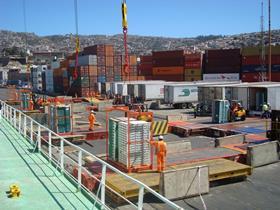
Just 10 days after Chile was struck by an 8.8-earthquake the Chilean Exporters Association (Asoex) has reported that the country’s fruit production and export sector is quickly returning to its prominent role in the national economy thanks to years of disaster planning.
“During this period we have had an important showing of support andconcern by our trade colleagues around the world, for which we aregrateful,” commented Ronald Bown, Asoex chairman.
“Our message today isthat our industry is up and running and working towards full normalityin the coming days.”
Roads & Ports
There have been reports in rural areas of some blocked roads and damaged bridges, which have impeded growers from returning to normality.
However, in general, the organisation said there has been a continuous and significant flow of traffic heading down the main access roads to the ports and the industry has been well served by the capacity of Chilean ports to take concentrated volumes at short notice.
“Operational equipment at the Ports of Valparaíso and San Antonio was repaired quickly and the Port of Coquimbo remained fully operational, giving much-needed preferential treatment to perishable products,” Asoex explained.
“Today (Tuesday 9 March) the Port of Valparaíso is operating normally, at a capacity of 95 per cent. The only pier to sustain serious damage (#4) is still being used while under repair thanks to creative solutions.”
Three of the piers at the Port of San Antonio, through STI (San Antonio Terminal Internacional), are functioning normally, Asoex said. And although cranes are being repaired at the port’s other two piers, ships are passing through the piers and using their own on-board cranes. In San Antonio’s EPSA (Empresa Portuaria de San Antonio) terminal, operations are at normal levels and at full capacity.
“The key message from the industry is that as of today, the distribution of fruit products from most regions to Chilean port facilities and onwards to international markets is back to normal schedules and unhindered by earthquake damage,” Asoex stated.
Electricity & Water Supply:
In some growing zones, Asoex said there have been some reports of lack of electricity and damage to water channels and reservoirs, resulting in irrigation problems and shortages to a limited level of production.
“The majority of electricity has been restored to both packing facilities and orchards,” the association explained. “Where the electrical grid went down, previously installed generators helped coldstorage facilities maintain the integrity of the cold chain for fruit ready for shipment.”
Packing:
Although some individual packhouses have sustained damage, Asoex added that the vast majority are up and running at normal capacity, and have been able to absorb fruit products initially destined to facilities currently under repair.






No comments yet